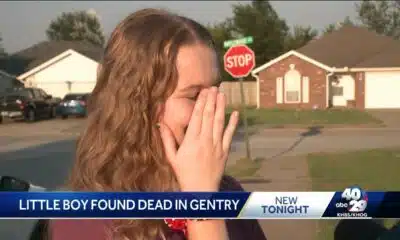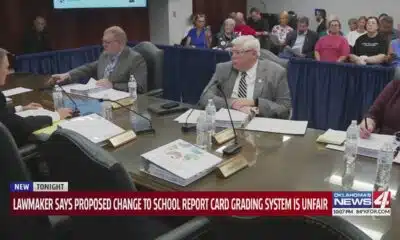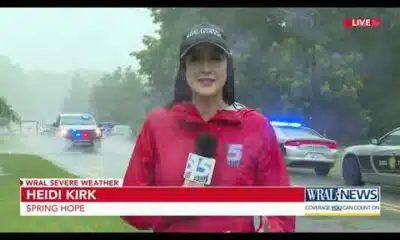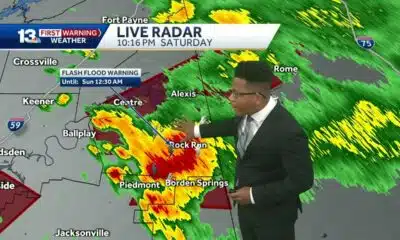News from the South - West Virginia News Feed
Measles cases are in 34 states with North Dakota now the focus
by Tim Henderson, West Virginia Watch
June 19, 2025
As super-contagious measles continues to spread and nears a six-year U.S. record, cases in its original epicenter of West Texas may be subsiding as hesitant residents become more concerned and willing to vaccinate, while North Dakota is a new focus with the highest rate of any state.
The reality of measles may be overcoming vaccine misinformation in some areas, despite the purge of experts from decision-making roles in the Trump administration under Health and Human Services Secretary Robert F. Kennedy Jr. The nation’s top vaccine expert resigned under pressure in March.
And on June 11, Kennedy appointed eight new members of an immunization advisory panel — some of whom are vaccine critics — after sacking all 17 members of the group two days earlier. Kennedy called his actions “a major step towards restoring public trust in vaccines.”
The University of Minnesota’s Center for Infectious Disease Research and Policy, however, called the committee’s mass replacement “one of the darkest days in modern public health history.” The Infectious Diseases Society of America called the move “reckless, shortsighted and severely harmful,” saying Kennedy’s criticism of the original 17 committee members is “completely unfounded.”
Now they’ve seen measles in their community so now they’re thinking, ‘OK, now I’m going to get vaccinated.’
– Katherine Wells, director of public health in Lubbock, Texas
In West Texas, where outbreaks are concentrated, the city of Lubbock hasn’t seen a new case in 20 days, said Katherine Wells, public health director for the city. The area is east of the largest Texas outbreaks, which were centered on a Mennonite community with religious objections to vaccination.
Wells attributed the recent success to a combination of more vaccinations, public awareness campaigns and willingness to stay home when sick to avoid transmission.
“I talked to some people who, because there’s so much information about the risk of vaccines and the bad side effects, I can see from a parent’s perspective, ‘Why would I give my child that?’” Wells said. “Now they’ve seen measles in their community, so now they’re thinking, ‘OK, now I’m going to get vaccinated.’”
Outbreak moves north
In North Dakota, however, the state’s 34 cases give it the highest rate in the nation, followed by New Mexico and Texas, according to the North Dakota Public Health Association, a nonprofit health advocacy group that published an analysis of individual states’ data on Facebook. The state’s first case since 2011 was reported May 2.
“This is not a result of local public health failure,” the organization posted. “This is a result of persons in the community choosing not to have their children vaccinated and resisting local public health recommendations and urgent efforts to increase vaccination uptake.”
Dr. Stephen McDonough, a pediatrician and former state health officer in North Dakota, said he hasn’t seen signs of improvement in the state. He doubts recent federal moves will do anything but make the situation worse.
“The outbreak in North Dakota is real, has not peaked yet and is expanding,” McDonough said in an interview. “It was just a matter of time before North Dakota experienced a measles outbreak due to our low immunization rate.”
Middle school band students in Minot, North Dakota, had to cancel trips to a regional band festival and parade in May because of the outbreak. Some 150 unvaccinated children were asked to quarantine for 21 days to avoid further spread.
North Dakota had a 90% vaccination rate among kindergarteners for the 2024-2025 school year, a number that has declined from about 95% in the 2019-2020 school year, according to state records. Vaccination coverage at 95% or above is needed to halt measles transmission.
North Dakota’s small population makes its measles rate misleading, said Jenny Galbraith, an immunization manager for the North Dakota Department of Health and Human Services.
However, the state has suffered from low vaccination rates in recent years as more parents have claimed exemptions based on personal philosophy, religion or other reasons as allowed by state law. With about 7% of children exempted, it’s almost impossible to reach the goal of 95% vaccination, she said.
One hopeful sign is that North Dakota hasn’t seen a new measles case since May 28, Galbraith said. “It’s hard to say it’s getting better because we’re not out of the woods yet,” she said.
It’s not always possible to overcome vaccine misinformation in the rural areas where it has taken root, said Lori Tremmel Freeman, CEO of the National Association of County and City Health Officials.
Increases in vaccination are generally in “areas where people are already comfortable getting vaccinated,” she said, rather than areas such as parts of North Dakota and Oklahoma “that are more leery of vaccines and harder to penetrate because of misinformation.” Texas County in Oklahoma has 16 confirmed cases, almost all among unvaccinated people.
But local officials can keep stressing the benefits of vaccination and also the need to stay home when measles symptoms appear, advice that those unwilling to vaccinate may be more likely to heed, Freeman said.
“In this day and age, it’s an embarrassment that we’ve lost three people to measles,” she said, referring to the three deaths reported this year.
‘Cautiously optimistic’ in Texas
According to a federal Centers for Disease Control and Prevention update June 13, there are 1,197 confirmed cases affecting 34 states. Navajo County, Arizona, reported the state’s first four cases this week.
There have been 21 measles outbreaks, defined as clusters of three or more related cases, this year compared with 16 in all of last year, according to the CDC. Cases are now more than four times higher than they were all of last year. And with less than half the year over, case numbers are closing in on 2019’s high of 1,274.
That’s still a small number compared with almost 28,000 cases in 1990, when an outbreak centered in California hit low-income areas with low vaccination rates.
While the total case count grows, the number of weekly new infections is dropping since a peak of 116 in late March.
In Texas, outbreaks have slowed as unvaccinated people have either gotten vaccinated or become infected and gained immunity, said Lara Anton, spokesperson for the Texas Department of State Health Services.
“The number of new cases in West Texas has slowed down and we are cautiously optimistic that this trend will continue,” Anton said.
The current list of states affected by confirmed measles cases this year: Alaska, Arizona, Arkansas, California, Colorado, Florida, Georgia, Hawaii, Illinois, Indiana, Iowa, Kansas, Kentucky, Louisiana, Maryland, Michigan, Minnesota, Missouri, Montana, Nebraska, New Jersey, New Mexico, New York, North Dakota, Ohio, Oklahoma, Pennsylvania, Rhode Island, South Dakota, Tennessee, Texas, Vermont, Virginia and Washington.
Stateline reporter Tim Henderson can be reached at thenderson@stateline.org.
GET THE MORNING HEADLINES.
West Virginia Watch is part of States Newsroom, a nonprofit news network supported by grants and a coalition of donors as a 501c(3) public charity. West Virginia Watch maintains editorial independence. Contact Editor Leann Ray for questions: info@westvirginiawatch.com.
The post Measles cases are in 34 states with North Dakota now the focus appeared first on westvirginiawatch.com
Note: The following A.I. based commentary is not part of the original article, reproduced above, but is offered in the hopes that it will promote greater media literacy and critical thinking, by making any potential bias more visible to the reader –Staff Editor.
Political Bias Rating: Center-Left
This article presents information on measles outbreaks and vaccination issues with a focus on public health and expert perspectives, critiquing actions by Robert F. Kennedy Jr. and vaccine misinformation. It highlights concerns from scientific and medical communities, portraying vaccine skepticism as detrimental to public health. The tone is generally supportive of vaccination efforts and critical of administrative decisions perceived as undermining expert guidance. While committed to factual reporting, the emphasis on expert criticism of government moves and vaccine hesitancy aligns slightly left of center in the U.S. political spectrum, reflecting a science- and public-health-oriented viewpoint common among Center-Left media. The piece refrains from partisan rhetoric but clearly supports evidence-based health policies.
News from the South - West Virginia News Feed
Katie's August 6 Evening Forecast
SUMMARY: Katie’s August 6 Evening Forecast reports a comfortable, humid Wednesday evening with humidity above 50% in most areas except Summersville at 49%. Temperatures will drop into the 70s and 60s overnight. Tonight remains mostly dry with clouds to the east. Tomorrow may bring scattered sprinkles from lunchtime through evening, but no major disruptions expected. Temperatures will be slightly cooler than usual, in the mid to upper 70s. The weekend promises pleasant weather with highs around 80-82°F, perfect for outdoor events and the fair. Overall, no major weather problems are expected in the coming days.
FOLLOW US ON FACEBOOK AND TWITTER:
https://facebook.com/WOAYNewsWatch
https://twitter.com/WOAYNewsWatch
News from the South - West Virginia News Feed
Historically redlined communities have slower EMS response times
by Nada Hassanein, West Virginia Watch
August 5, 2025
Residents of historically redlined communities experience slower response times from emergency medical services, according to a study published Tuesday in JAMA Network Open.
Redlining refers to the discriminatory practice under which the federal government and banks systematically denied mortgages to Black and Hispanic residents. The practice deemed neighborhoods with higher proportions of nonwhite residents to be undesirable and financially risky for mortgage lending.
Researchers mapped locations of EMS centers across 236 cities and analyzed maps produced in the 1930s by the Home Owners’ Loan Corporation. The government agency, created as part of the New Deal, consistently ranked majority-Black areas as “hazardous” for lending. Redlining has been illegal since enactment of the federal Fair Housing Act in 1968.
The research team calculated average EMS response times using the location of ambulance, fire and rescue services and historical traffic data. “Rapid” response was defined as five minutes or less, the benchmark set by the National Fire Protection Association for high-priority patients with life-threatening conditions.
The team found that more than 2.2 million people lack rapid EMS access. Areas historically graded “D” — financially “hazardous” for mortgage lending — had a significantly higher proportion of residents (roughly 7%) without rapid EMS access, compared with about 4% of residents in historically “most desirable” A-graded neighborhoods. D-graded neighborhoods had higher proportions of Black residents, whereas A-graded neighborhoods had more white residents.
Disparities were particularly acute in the Great Lakes region, the authors note. The odds of lacking rapid access to EMS were nearly three times higher for residents in historically D-graded neighborhoods, compared with A-graded neighborhoods in that region.
The findings add to the evidence linking policies rooted in structural racism to health disparities.
Research has shown redlined neighborhoods still disproportionately grapple with a multitude of health disparities, lower life expectancy and more exposure to air pollution.
The study found a racial disparity in where EMS stations are located, with fewer EMS stations in urban communities of color. Better tracking and accountability of EMS response times in communities could help address the issue, the researchers wrote.
Delays in emergency care are associated with higher mortality rates. For traumatic injuries, timely care is critical during what EMS professionals call the “golden hour,” or the first 60 minutes after an injury.
Other research has pointed to disparities in emergency response times. EMS response times for patients with cardiac arrest, for example, were 10% longer for low-income ZIP codes than high-income ZIP codes, according to a national study published in JAMA Network Open in 2018.
The study received funding support from the National Institutes of Health’s National Institute of Minority Health and Health Disparities.
Stateline reporter Nada Hassanein can be reached at nhassanein@stateline.org.
West Virginia Watch is part of States Newsroom, a nonprofit news network supported by grants and a coalition of donors as a 501c(3) public charity. West Virginia Watch maintains editorial independence. Contact Editor Leann Ray for questions: info@westvirginiawatch.com.
The post Historically redlined communities have slower EMS response times appeared first on westvirginiawatch.com
Note: The following A.I. based commentary is not part of the original article, reproduced above, but is offered in the hopes that it will promote greater media literacy and critical thinking, by making any potential bias more visible to the reader –Staff Editor.
Political Bias Rating: Center-Left
This content presents a fact-based exploration of how historical redlining—an explicitly racial and economic discriminatory practice—continues to impact disparities in emergency medical service response times. It highlights systemic inequalities and racial disparities consistent with social justice concerns more frequently emphasized in center-left discourse. The piece supports the view that structural racism has long-term effects and implicitly advocates for policy attention and accountability in emergency services, aligning with a center-left perspective on addressing inequality and promoting equity in public services. However, it maintains a measured tone and relies heavily on research and data, avoiding overt partisan rhetoric.
News from the South - West Virginia News Feed
Boone St. crossing unsafe to walk across
SUMMARY: A coal train with 220 cars, weighing 54 million pounds, derailed late Saturday night in Saint Albans. Due to the derailment, the police department warns that the crossing at the Boone Street tunnel is unsafe for pedestrians. CSX, the railroad company, states that track repair equipment will be moved periodically through the area, further increasing the hazard. Residents are strongly advised not to walk across the Boone Street crossing until repairs are completed and it is deemed safe. Authorities continue monitoring the situation to ensure public safety during the ongoing repair work.
Boone St. crossing unsafe to walk across
For more Local News from WSAZ: https://www.wsaz.com/
For more YouTube Content: https://www.youtube.com/channel/UCrcuU0JXXy8oIBqEB13mrwA
-
Mississippi Today5 days ago
After 30 years in prison, Mississippi woman dies from cancer she says was preventable
-
News from the South - Georgia News Feed6 days ago
Woman charged after boy in state’s custody dies in hot car
-
News from the South - North Carolina News Feed3 days ago
Two people unaccounted for in Spring Lake after flash flooding
-
News from the South - Florida News Feed6 days ago
Warning for social media shoppers after $22K RV scam
-
News from the South - Texas News Feed5 days ago
Texas redistricting: What to know about Dems’ quorum break
-
News from the South - Texas News Feed7 days ago
Texas VFW holds memorial service for WWII pilot from Georgetown
-
News from the South - Georgia News Feed5 days ago
Georgia lawmakers to return this winter to Capitol chambers refreshed with 19th Century details
-
News from the South - Alabama News Feed7 days ago
Flood Watch for Alabama: Storms linger overnight, with cooler weather in the forecast








































